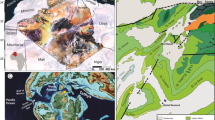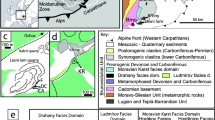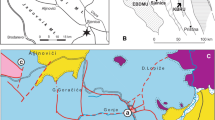Abstract
In Germany tens to hundreds of kilometres-laterally distributed sedimentological heterogene crinoid accumulation bed with partly articulated Encrinus liliiformis specimens is dated within a complete trans-regression cycle of higher order into the upper Illyrian, Anisian (Middle Triassic, pulcher biozone). The crinoid bearing layer differs much from under- and overlaying tempestite parasequence sets of the Meißner Formation. The tsunamite layer consists of different laterally grain size sorted facies types ranging from unsorted bioclastic floatstones of large-scaled antidune megaripples, which continue in oscillation-ripple-marked oolithic grainstone surfaces that end into crinoid filled scour troughs in wacke/mudstones (=horizontal grain sorting in backwash direction). The tsunamite bed of Lamerden that consists of mixed reworked oolithic bar to crinoid ramp facies areas (sediments/biota to the outer ramp facies) can be correlated to a crinoid bed of Bissendorf within northwestern Germany at minimum (about 50 km) and appears within the tectonical deepening period of the Central European intracratonic Germanic Basin. The heterotope crinoid taphocoenosis was built in the outer ramp Tonplatten facies, in the deepest part of the Germanic Basin (Hesse-Depression) due to backwash. The mixed macro fauna originate from the crinoid bioherms and terebratulid hardgrounds of the inner/middle ramp facies (such as the sediments). From 350 analysed crinoid individuals (of 1500), only 1 % are complete with 120–160 cm short-stemmed ecotypes of the inner ramp crinoid meadows which settled along the sand bars basinwards. The Lamerden crinoids are scattered or are concentrated differently condensed in scour trough-like structures on wackestones/mustone areas and more rare or scattered on osciallation-ripple marked grainstones and allow only local bottom current estimations. In interfingering floatstones, more rare crowns are found unsorted within dominat chaotic oriented terebratulids. Most crinoid specimens (83 %) were found with relic stems and the others (16 %), only as crowns. The echinoderms survived a tsunami event, for at least a few hours/days under 10–30 cm of mud coverage. Only 1 % of the crowns have opened arms (=postmortal embedding); all others (99 % are closed crowns) are “buried alive” specimens. The crinoids closed the nutrition canal immediately and started regeneration of the distal stem for new attachment purposes; therefore, those have all rounded distal stems. The northern German Lamerden crinoid layer is most similar to the southern German Neckarwestheim site, but is different in its origin to other German sites, where crinoids have been found around bioherms or with long-stemmed specimens not far from their patch-reef like habitats in channels of the upper middle ramp facies. The tsunamite demonstrate the problem of the “Triassic time scale” which is tempestite and Milankovitch cycle based on an intracratonic basin, because there seem to be several further tsunamite bioclastic layers, which were misidentified as “tempestites”.















Similar content being viewed by others
References
Agricola G (1546) De natura fossilium. Marix, Wiesbaden, pp 434
Aigner T (1985) Storm depositional systems. Lect Note Earth Sci 3:1–174
Aigner T (1993) Sequence stratigraphy of the Germanic Basin. In: Hagdorn H, Seilacher A (eds) Muschelkalk. Schöntaler Symposium, Goldschneck-Verlag, pp 15–18
Aigner T, Futterer E (1978) Fossil-Lagerstätten Nr.44: Kolk-Töpfe und -Rinnen (pot and gutter casts) im Muschelkalk—Anzeiger für Wattenmeer? N Jb Geol Paläont Abh 156:285–304
Bachmann GH, Aref MAM (2005) A seismite in Triassic gypsum deposits (Grabfeld Formation, Ladinian), Southwest Germany. Sediment Geol 180:75–89
Bachmann GH, Kozur HW (2004) The Germanic triassic: corelations with the international chronostratigraphic scale, numerical ages and Milankovitch cyclicity. Hall Jb Geowissensch B 26:17–62
Baumiller TK, Gahn FJ, Hess H, Messing CG (2008) Taphonomy as an indicator of behavior among fossil crinoids. In: Ausich WI, Webster GD (eds) Echinoderm paleobiology. Indiana University, Press, pp 7–20
Cantalamessa G, Di Celma C (2005) Sedimentary features of tsunami backwash deposits in a shallow marine Miocene setting, Mejillones Peninsula, northern Chile. Sed Geol 178:259–273
de Lamarck JBPAM (1816) Histoire naturelle des Animaux sans vertèbres, vol 2. Verdière Librairie, Paris, p 568
Diedrich C (2003) Ein Ceratiten-Pflaster aus der penndorfi-Zone des Oberen Muschelkalkes (Mitteltrias) Nordhessens (Nord-Deutschland). Philippia 11(2):93–102
Diedrich C (2008a) Subtidale Kolke und Rinnen eines Sturmevents im Bereich der compressus-Zone sowie Stratigraphie und Paläoenvironment im Oberen Muschelkalk (Anis/Ladin) von Bissendorf (NW-Deutschland). N Jb Geol Paläont Abh 250(3):7–27
Diedrich C (2008b) Millions of reptile tracks—early to Middle Triassic carbonate tidal flat migration bridges of Central Europe. Palaeogeogr Palaeoclimat Palaeoec 259(2008):410–423
Diedrich C (2009a) The vertebrates of the Anisian/Ladinian boundary (Middle Triassic) from Bissendorf (NW Germany) and their contribution to the anatomy, palaeoecology, and palaeobiogeography of the Germanic Basin reptiles. Palaeogeogr Palaeoclimat Palaeoec 273:1–16
Diedrich C (2009b) Palaeogeographic evolution of the marine Middle Triassic marine Germanic Basin changements—with emphasis on the carbonate tidal flat and shallow marine habitats of reptiles in Central Pangaea. Glob Planet Change 65:27–55
Diedrich C (2010) Huge accumulations of giant shell adapting Upper Cretaceous ammonites as benthic islands of Central Europe. J Int Geosci Epis 2010:164–172
Diedrich C (2011a) Fossil Middle Triassic “sea cows”—placodont reptiles as macroalgae feeders along the North-western Tethys coasts. Nat Sci 3(1):8–26
Diedrich C (2011b) Middle Triassic limulid crustacean reproduction intertidal flats of Europe and contribution to the variability of Kouphichnium Nopcsa 1923 tracks—early Mesozoic limulid mating migrations into the Germanic Basin and reptile food chain reactions. Biol J Linn Soc Lond 103:76–105
Diedrich C (2012a) The Middle Triassic marine reptile biodiversity in the Germanic Basin in the centre of the Pangaean world. Cent Eur J Geosci 4(1):9–46
Diedrich C (2012b) Middle Triassic chirotherid trackways on earthquake influenced intertidal limulid reproduction flats of the European Germanic Basin coasts. Cent Eur J Geosci 4(3):495–529
Diedrich C (2012c) The Central Europe Germanic Basin shallow marine placodont Cyamodus—its evolution, palaeobiogeography and palaeoecology. Hist Biol 23(4):391–409
Diedrich C (2013a) Shallow marine sauropterygian reptile biodiversity and change in the Bad Sulza Fm (Illyrian, Middle Triassic) of Central Germany—and a contribution to the evolution of Nothosaurus in the Germanic Basin. New Mex Mus Nat Hist Sci 61:132–158
Diedrich C (2013b) The “Middle Triassic Sea Cow” reptile Placodus gigas (Reptilia) populations of Pangaea’s shallow marine macroalgae habitats. New Mex Mus Nat Hist Sci 61:104–130
Diedrich C (2014) The vertebrates from the Lower Ladinian (Middle Triassic) bonebed of Lamerden (Germany) and contribution to Blezingeria ichtyospondyla from the Germanic Basin. Cent Eur J Geosci (accepted)
Duringer P (1984) Tempetês et tsunamis: des dépôts de vagues de haute énergie intermitente dans le Muschelkalk supérieur (Trias germanique) de l’Est de la france. Bull Soc géol France 26:11777–11785
Flohr K (1999) Fossile Fauna des Oberen Muschelkalkes in Ostwestfalen-Lippe. Sonderver Naturw-Hist Ver Land Lippe 52:1–147
Flügel E (2004) Microfacies of carbonate rocks. Springer, Berlin
Föhlisch K (2007) Überlieferungen seismischer Aktivität im Unteren Muschelkalk. Beitr Geol Thüringens N F 14:55–83
Föhlisch K, Voigt T (2001) Synsedimentary deformation in the lower Muschelkalk of the Germanic Basin. Spec Publ Int Assoc Sediment 31:279–297
Fredd D (1994) Unser Traum—ein Massenvorkommen von Encrinus liliiformis in Lamerden. Arbeitskr Paläont Hannover 3:61–80
Furrer H (1995) The Kalkschieferzone (Upper Meride Limestone Ladinian) near Meride (Canton Ticino, Southern Switzerland) and the evolution of a Middle Triassic intraplatform basin. Ecl geol Helv 88(3):827–852
Fürsich FT (1981) Die Entalis-Faunengemeinschaft in Weichböden des Oberen Muschelkalkes. In: Mc Kerrow WS (ed) Palökologie. Schweizerbart, Stuttgart, pp 134–135
Hagdorn H (1978) Muschel/Krinoiden-Bioherme im Oberen Muschelkalk (mo1, Anis) von Crailsheim und Schwäbisch Hall (Südwestdeutschland). N Jb Geol Paläont Abh 156:31–86
Hagdorn H (1991) The Muschelkalk in Germany- an introduction. In: Hagdorn H (ed) Muschelkalk: A field guide. Goldschneck, Korb, pp 7–21
Hagdorn H (2004) Muschelkalkmuseum Ingelfingen. Edition Lattner, Ingelfingen, p 88
Hagdorn H (2011) Triassic: the crucial period of post-palaeozoic crinoid diversification. Swiss J Palaeont 130:91–112
Hagdorn H, Ockert W (1991) Encrinus liliiformis im Trochitenkalk Süddeutschlands—In: Hagdorn H, Seilacher A (eds) Muschelkalk: Schöntaler Symposium. Goldschneck-Verlag, Stuttgart, pp 245–260
Hagdorn H, Simon T (1993) Ökostratigraphische Leitbänke im Oberen Muschelkalk. In: Hagdorn H, Seilacher A (eds) Muschelkalk. Schöntaler Symposium, Goldschneck-Verlag, pp 193–208
Hesse R (1991) Untersuchungen an einem monotypischem Fund von Encrinus liliiformis aus dem Oberen Muschelkalk bei Bad Driburg. Geol Paläont West 19:7–46
Horn MB (1974) Trias. In: Hessische Amt für Bodenforschung (ed) Geologische Karte von Hessen und Erläuterungen, Blatt 4521 Liebenau, pp 15–61
Hüssner H (1991) Rifftypen im Muschelkalk Süddeutschlands. In: Hagdorn H, Seilacher A (eds) Muschelkalk. Schöntaler Symposium, Goldschneck-Verlag, pp 261–269
Jefferies RPS (1989) The arm structure and mode of life of the Triassic crinoid Encrinus liliiformis. Palaeontology 32:483–497
Knaust D (1998) Trace fossils and ichnofabrics on the Lower Muschelkalk carbonate ramp (Triassic) of Germany: tool for heigh resolution sequence stratigraphy. Geol Rundsch 87:21–31
Knaust D (2000) Signatures of tectonically controlled sedimentation in Lower Muschelkalk carbonates (Middle Triassic) of the Germanic Basin. Zbl Geol Paläont I 1998(9–10):893–924
Kozur HW, Bachmann GH (2008) Updated correlation of the Germanic Triassic with the Tethyan scale and assigned numeric ages. Berichte der Geologisches Bundesanstalt Wien 76:53−58
Linck O (1954) Die Muschelkalk-Seelilie Encrinus Liliiformis, Ergebnisse einer Grabung. Aus der Heimat 62:225–235
Linck O (1965) Stratigraphische, stratinomische und ökologische Betrachtungen zu Encrinus liliiformis Lamarck. Jh geol Land Baden-Württem 7:123–148
Michalík J (1997) Tsunamites in a storm-dominated Anisian carbonate ramp (Vysoka- Formation, Malé Karpaty Mts., Western Carpathians). Geol Carpath 48:221–229
Pomar L (2001) Types of carbonate platforms: a genetic approach. Basin Res 13:313–334
Rein S (2001) Neue Erkenntnisse zur Evolution der germanischen Ceratiten—Ontogenese, Phylogenese und Dimorphismus. Freib Forschungsh 9:99–120
Rhode P (1963) Der tiefere Teil des Oberen Muschelkalkes im Nordlippischen Weserbergland (Beispiel einer für den nord- und mitteldeutschen Raum normalen Entwicklung). N Jb Geol Paläont Abh 117:303–314
Röhl U (1986) Feinstratigraphie und Mikrofazies des Oberen Muschelkalkes im Hildesheimer Wald. N Jb Geol Pal Mh 1986(8):489–511
Röhl U (1990) Parallelisierung des norddeutschen oberen Muschelkalkes mit dem süddeutschen Hauptmuschelkalk anhand von Sedimentationszyklen. Geol Rundsch 79:13–26
Röhl U (1993) Sequenzstratigraphie im zyklisch gegliederten Oberen Muschelkalk Norddeutschlands. In: Hagdorn H, Seilacher A (eds) Muschelkalk. Schöntaler Symposium, Goldschneck-Verlag; Stuttgart, pp 29–36
Rose K-H (1986) Ceratiten-Verbreitung im Oberen Muschelkalk des Weserberglandes am Beispiel der Profile von Daspe und Großenberg. Aufschluß 37:294–312
Szulc J (1998) Anisian–Carnian evolution of the Germanic Basin and its eustatic, tectonic and climate controls. Zbl Geol Paläont I 7–8:813–852
Szulc J (2007) Muschelkalk. In: Szulc J, Becker A (eds) International workshop on the Triassic of southern Poland, Fieldtrip guide. Institute of Geological Sciences, Jagiellonian University, Cracow, pp 29–33
Urlichs M, Mundlos R (1990) Zur Ceratitenstratigraphie im Oberen Muschelkalk (Mitteltrias) Nordwürttembergs. Jahresschr Ges Naturk Württemb 145:59–74
Urlichs M, Vath U (1990) Zur Ceratitenstratigraphie im Oberen Muschelkalk (Mitteltrias) bei Göttingen (Südniedersachsen). Geol Jb Hessen 118:127–147
von Schlotheim EF (1820) Die Petrefactenkunde auf ihrem jetzigen Standpunkte durch die Beschreibung seiner Sammlung versteinerter und fossiler Überreste des Thier- und Pflanzenreichs der Vorwelt erläutert. Gotha, Becker, p 438
Wagner R (1957) Die Germanischen Ceratiten. Palaeontogr A 108:57–129
Weissmüller A (1998) Ein umfangreicher Fund von Encrinus liliiformis Lamarck im Oberen Muschelkalk (mo2) des Diemeltales (Nordhessen). Philippia 8(4):245–270
Wright VP, Burchette TP (1998) Carbonate ramps: an introduction. Geol Soc Lond Spec Publ 149:1–5
Acknowledgments
The quarry and property owners H. and A. Fischer helped in every way to protect the site since 2006, rescuing the finds and “crinoid bed”. Many backhoe hours were sponsored by the Fischer GmBH & Co KG company in 2006 to rescue the “palaeontological monument”, with the backhoe operator S. Nummer doing a great job to expose the crinoid bed without harming any crinoid with the large and heavy machine. The discovery was made possible only by A. Fischer, who was there at the time of discovery with the author. I thank I. Banasik (financed by the DFG, project DI 911/3-1) for her great preparation work of crinoids on place in 2006. Scientific research and the detailed documentation of the site and crinoid layer, published herein, were finally sponsored solely by the private research institute PaleoLogic (www.paleologic.eu). Finally, the work is dedicated to Dr. M. Týblová, who supported the author much in the hard time of the Multiple Sklerose treatments in the MS clinic in Prague, when the paper was in its final stage.
Author information
Authors and Affiliations
Corresponding author
Rights and permissions
About this article
Cite this article
Diedrich, C. Tsunami killed and backwashed accumulated crinoids in Middle Triassic (Anisian) intracratonic Germanic Basin carbonates of central Europe. Carbonates Evaporites 32, 435–458 (2017). https://doi.org/10.1007/s13146-017-0391-0
Accepted:
Published:
Issue Date:
DOI: https://doi.org/10.1007/s13146-017-0391-0




